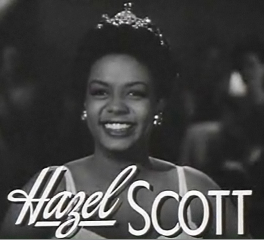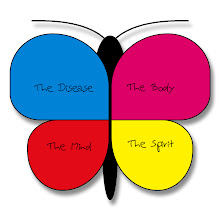2001: A Space Odyssey "The Dawn of Man"
Posted by Musings of a Lupus Survivor! Thursday, February 5, 2009 at 8:53 AM 0 comments Labels: film, images, opinion
Hazel Scott Discovered!

Her album Relaxed Piano Moodson the Debut Record label with Charles Mingus and Max Roach, is the album most highly regarded by critics today.
She was married to U.S. Congressman Adam Clayton Powell, Jr. from 1945 to 1956, by whom she had one child before their divorce, Adam Clayton Powell III. Enjoy these video clips. Rhapsody in Blue was removed from YouTube...copyright issues.
Takin' A Chance--Hazel Scott
Hazel Scott Body and Soul
Hazel Scott for the March of Dimes featuring Hazel Scott & Charles Mingus performing "Foggy Day"
TCM Behind the Scenes
American Psycho's Misogynism: Gloria Steinem, I Disagree

Feminist activist Gloria Steinem was among those opposed to the release of Ellis' book because of its portrayal of violence towards women. Steinem is also the stepmother of Christian Bale, who portrayed Bateman in the film adaptation of the novel.
My thoughts are that misogynists are a fact of life. Men are most often misogynistic more often than not; therefore, the author is simply making his statements about the reality of a misogynistic superficial desensitized contemporary culture. I don't see this sexually explicit and violence novel as a promotion of either the sex or the violence but as exaggerated allegorical expression of what already exists.
Posted by Musings of a Lupus Survivor! Thursday, January 29, 2009 at 5:54 PM 0 comments Labels: film, opinion
The Apartment: Billy Wilder's homage to King Vidor's The Crowd
Watch scene at 2:45
When Billy Wilder made ''The Apartment'' in 1960, ''the organization man'' was still a current term. One of the opening shots in the movie shows Baxter as one of a vast horde of wage slaves, working in a room where the desks line up in parallel rows almost to the vanishing point. This shot is quoted from King Vidor's silent film ''The Crowd'' (1928), which is also about a faceless employee in a heartless corporation. Cubicles would have come as revolutionary progress in this world.--RogertEbert.com
Watch scene at 7:20
Imitation of Life: Race of Actresses playing Sara Jane
Before the 1959 version of Imitation of Life starring Lana Turner that Claudette Colbert starred in 1934 Academy Award nominated film by the same title based on Fannie Hurst's 1933 novel of the same name . The film was nominated for an Academy Award. In 2007 Time magazine named it among the "The 25 Most Important Films on Race".
Fredi Washington plays Peola, the daughter ashamed of her African-American heritage, that attempts to pass as white. The casting of such a role was a rare opportunity for a light-complexioned actresses of her time. In fact she was lucky to cast at all. Extremely fair skinned with green eyes she didn't fit the "maid" roles reserved for Negro actresses of her time.
The role had poignant meaning for Washington, as she turned down a number of opportunities to pass for white as an actress. If she had chosen to do so, she might have become a movie star. Of mixed race with a light complexion, green eyes, and great beauty, Washington found it hard to win roles and audiences given the limited opportunities of the time. She was too light skinned and elegant to play stereotypical "maid" roles. Because she was African American, however, Hollywood directors did not offer her romantic roles with leading white actors. General romances did not then feature African Americans. When Washington played roles in films for black audiences, she often wore heavy makeup to darken her skin.
After Imitation of Life, Washington had one more decent role (4th billing) in Fox's One Mile from Heaven (1937). Realizing that there was no future in Hollywood for an African-American actress with ivory-toned skin, Washington quit movies altogether and returned to New York to work in theater. -- Wikipedia
Unfortunately no opportunity was given to any light-complexioned actress for the 1959 remake. The actress playing Sarah Jane was not mulatto.

Although many African Americans were screen-tested for the corresponding Sarah Jane role in the 1959 remake, Susan Kohner, of Mexican and Czech Jewish descent, won the role. Karin Dicker, of Jewish decent, made her film debut as the young Sarah Jane in this film. -- Wikipedia
Billion Dollar Brain (1967): Alexander Nevsky's Ice battle
 Billion Dollar Brain is a 1967 Ken Russell film based on the novel Billion-Dollar Brain by Len Deighton. The film features Michael Caine as secret agent 'Harry Palmer', the anti-heroic protagonist of the cinematic versions of The IPCRESS File (1964) and Funeral in Berlin (1965).
Billion Dollar Brain is a 1967 Ken Russell film based on the novel Billion-Dollar Brain by Len Deighton. The film features Michael Caine as secret agent 'Harry Palmer', the anti-heroic protagonist of the cinematic versions of The IPCRESS File (1964) and Funeral in Berlin (1965).
The film's plot relies heavily upon the sophisticated 'brain' (computer) with which the FFF controls its Latvian anti-Soviet spy network. The film directly refers to the ice battle in Alexander Nevsky (1938), by Sergei Eisenstein.
Ice Battle of Lake Peipus
Several films have scenes strongly influenced by the Battle of Lake Peipus, including Doctor Zhivago (1965), Mulan (1998), and King Arthur (2004). However, the most striking homage appears during the culminating battle in Billion Dollar Brain.
Alexander Nevsky (1938)
This Soviet film portrays the struggle of Prince Alexander Nevsky and the citizens of Novgorod against invasion by the knights of the Crusading Order of the Teutonic Knights, culminating in the epic battle on the ice of Lake Chudskoe (Peipius). Prince Alexander Nevsky was later canonized by the Russian Orthodox Church and became a Russian national hero. This film was produced on the eve of World War II and alludes to the threat of Nazi Germany (note the swastikas on the Catholic bishop's mitre). Its showing was suppressed during the period of German-Soviet Non-Agression pact (9/39 to 6/41), but revived after the Nazi invasion. It was directed by Sergei Eisenstein with Nikolai Cherkasov in the title role.
Posted by Musings of a Lupus Survivor! Friday, August 1, 2008 at 7:16 AM 0 comments Labels: film, images
Join The Network
About Me

- Musings of a Lupus Survivor!
- As The Survivor of surviving a chronic invisible illness, I share "The Musings" on my life, mind, body & spirit.




